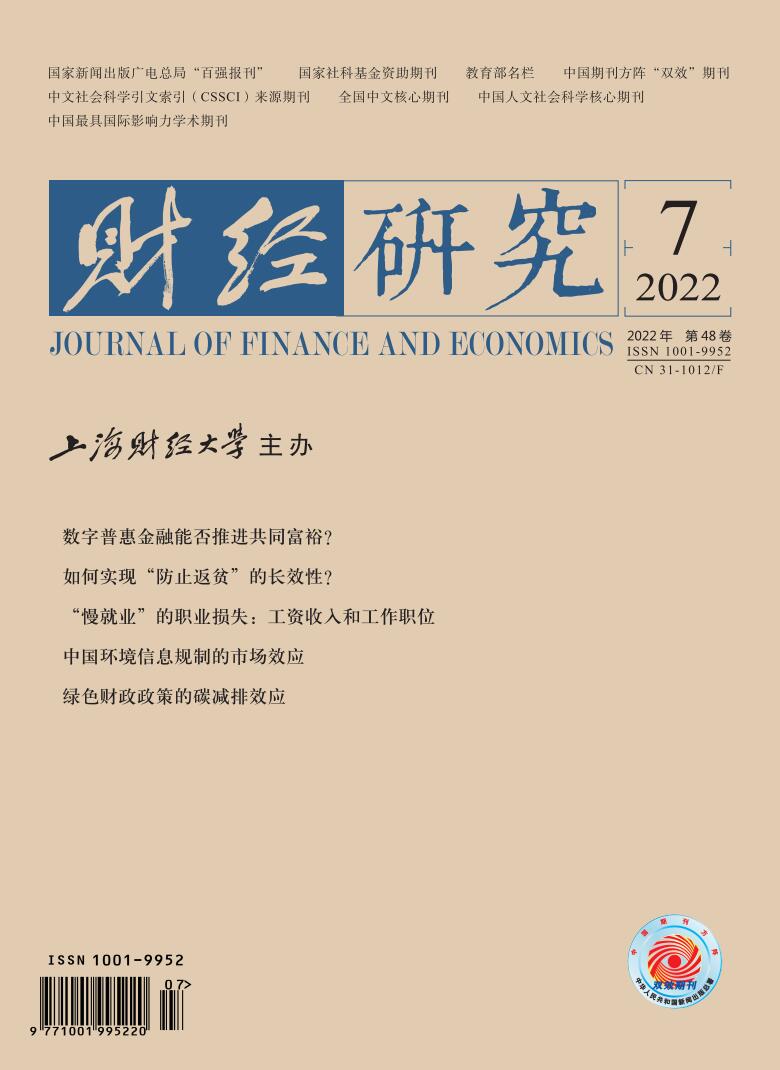在数字技术深度渗透经济循环和政府千方百计扩大就业的背景下,尽管大量文献关注到数字化对劳动就业的影响,但却普遍忽视了最具增长潜力的女性就业。基于偏向型技术进步理论,文章将理工科技能和社交技能作为与数字化互补的非常规技能,将体力技能作为与数字化互斥的常规技能,采用职业名称词典法提取劳动者的相关技能,并利用中国劳动力动态调查(
数字化变革、非常规技能溢价与女性就业
摘要
参考文献
摘要
1 柏培文, 喻理. 数字经济发展与企业价格加成: 理论机制与经验事实[J]. 中国工业经济,2021,(11):59−77. DOI:10.3969/j.issn.1006-480X.2021.11.004
4 马双, 李雪莲, 蔡栋梁. 最低工资与已婚女性劳动参与[J]. 经济研究,2017,(6):153−168. DOI:10.3969/j.issn.1672-5719.2017.06.127
7 戚聿东, 褚席. 数字生活的就业效应: 内在机制与微观证据[J]. 财贸经济,2021,(4):98−114. DOI:10.3969/j.issn.1002-8102.2021.04.007
9 宋月萍. 数字经济赋予女性就业的机遇与挑战[J]. 人民论坛,2021,(30):82−85. DOI:10.3969/j.issn.1004-3381.2021.30.017
15 Acemoglu D. Equilibrium bias of technology[J]. Econometrica,2007,75(5): 1371−1409. DOI:10.1111/j.1468-0262.2007.00797.x
17 Aksoy C G, Özcan B, Philipp J. Robots and the gender pay gap in Europe[J]. European Economic Review,2021,134: 103693. DOI:10.1016/j.euroecorev.2021.103693
18 Autor D H, Levy F, Murnane R J. The skill content of recent technological change: An empirical exploration[J]. The Quarterly Journal of Economics,2003,118(4): 1279−1333. DOI:10.1162/003355303322552801
19 Bacolod M. Skills, the gender wage gap, and cities[J]. Journal of Regional Science,2017,57(2): 290−318. DOI:10.1111/jors.12285
20 Becker G S. A theory of the allocation of time[J]. The Economic Journal,1965,75(299): 493−517. DOI:10.2307/2228949
21 Black S E, Spitz-Oener A. Explaining women’s success: Technological change and the skill content of women’s work[J]. The Review of Economics and Statistics,2010,92(1): 187−194. DOI:10.1162/rest.2009.11761
22 Borghans L, Ter Weel B, Weinberg B A. People skills and the labor-market outcomes of underrepresented groups[J]. ILR Review,2014,67(2): 287−334. DOI:10.1177/001979391406700202
23 Cortes G M, Jaimovich N, Siu H E. The "end of men" and rise of women in the high-skilled labor market[R]. Working Paper 24274, 2018.
24 Deming D J. The Growing importance of social skills in the labor market[J]. The Quarterly Journal of Economics,2017,132(4): 1593−1640. DOI:10.1093/qje/qjx022
26 Fossen F M, Sorgner A. New digital technologies and heterogeneous wage and employment dynamics in the United States: Evidence from individual-level data[J]. Technological Forecasting and Social Change,2022,175: 121381. DOI:10.1016/j.techfore.2021.121381
27 Frey C B, Osborne M A. The future of employment: How susceptible are jobs to computerisation?[J]. Technological Forecasting and Social Change,2017,114: 254−280. DOI:10.1016/j.techfore.2016.08.019
28 Gelbach J B. When do covariates matter? And which ones, and how much?[J]. Journal of Labor Economics,2016,34(2): 509−543. DOI:10.1086/683668
29 Gray M L, Suri S. Ghost work: How to stop silicon valley from building a new global underclass[M]. Boston: Harper Business, 2019.
30 Haraway D J. Simians, cyborgs, and women: The reinvention of nature[M]. New York: Routledge, 2013.
31 Hardy W, Keister R, Lewandowski P. Educational upgrading, structural change and the task composition of jobs in Europe[J]. Economics of Transition,2018,26(2): 201−231. DOI:10.1111/ecot.12145
32 Hilbert M. Digital gender divide or technologically empowered women in developing countries? A typical case of lies, damned lies, and statistics[J]. Women’s Studies International Forum,2011,34(6): 479−489. DOI:10.1016/j.wsif.2011.07.001
33 Ingram B F, Neumann G R. The returns to skill[J]. Labour Economics,2006,13(1): 35−59. DOI:10.1016/j.labeco.2004.04.005
34 Katz L F, Krueger A B. The rise and nature of alternative work arrangements in the United States, 1995-2015[J]. ILR Review,2019,72(2): 382−416. DOI:10.1177/0019793918820008
35 Lise J, Postel-Vinay F. Multidimensional skills, sorting, and human capital accumulation[J]. American Economic Review,2020,110(8): 2328−76. DOI:10.1257/aer.20162002
36 McAdam M, Crowley C, Harrison R T. Digital girl: Cyberfeminism and the Emancipatory potential of digital entrepreneurship in emerging economies[J]. Small Business Economics,2020,55(2): 349−362. DOI:10.1007/s11187-019-00301-2
37 Moore K, Griffiths M, Richardson H, et al. Gendered futures? Women, the ICT workplace and stories of the future[J]. Gender, Work & Organization,2008,15(5): 523−542.
39 Plant S. Zeroes and ones: Digital women and the new technoculture[M]. New York: Doubleday, 1997: 4.
41 Sorgner A, Bode E, Krieger-Boden C. The effects of digitalization on gender equality in the G20 economies[M]. Kiel: Kiel Institute for the World Economy, 2017.
42 Sovbetov Y. Impact of digital economy on female employment: Evidence from Turkey[J]. International Economic Journal,2018,32(2): 256−270. DOI:10.1080/10168737.2018.1478868
43 Stinebrickner T R, Stinebrickner R, Sullivan P J. Job tasks and the gender wage gap among college graduates[R]. Working Paper 24790, 2018.
44 Weinberger C J. The increasing complementarity between cognitive and social skills[J]. The Review of Economics and Statistics,2014,96(5): 849−861. DOI:10.1162/REST_a_00449
45 Welch F. Growth in women’s relative wages and in inequality among men: One phenomenon or two?[J]. American Economic Review,2000,90(2): 444−449. DOI:10.1257/aer.90.2.444
46 Yamaguchi S. Changes in returns to task-specific skills and gender wage gap[J]. The Journal of Human Resources,2018,53(1): 32−70. DOI:10.3368/jhr.53.1.1214-6813R2
引用本文
李建奇. 数字化变革、非常规技能溢价与女性就业[J]. 财经研究, 2022, 48(7): 48-62.
导出参考文献,格式为:





 5216
5216  5359
5359

